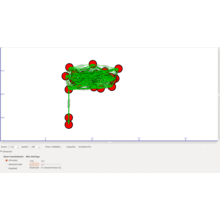NS3 Vanet Projects
Applications of NS3 Vanet Projects:
- Mobility modeling.
- Dynamic topology.
- Road traffic safety.
- Frequent disconnections.
- Predictable mobility patterns.
- Traffic efficiency.
- Comfort and quality of road travel.
- Stringent delay constraint.
Challenges Faced in NS3 Vanet Projects:
- Provisioning of QoS.
- Bandwidth consideration.
- Individual privacy among vehicles.
- Security to vehicle.
- High connectivity among network.

Sample code for NS3 Vanet Projects:
This is the sample code for simple VANET network. Using NS3 simulator.
#include “ns3/vector.h”
#include “ns3/string.h”
#include “ns3/socket.h”
#include “ns3/double.h”
#include “ns3/config.h”
#include “ns3/log.h”
#include “ns3/command-line.h”
#include “ns3/mobility-model.h”
#include “ns3/yans-wifi-helper.h”
#include “ns3/position-allocator.h”
#include “ns3/mobility-helper.h”
#include “ns3/internet-stack-helper.h”
#include “ns3/ipv4-address-helper.h”
#include “ns3/ipv4-interface-container.h”
#include
#include “ns3/ocb-wifi-mac.h”
#include “ns3/wifi-80211p-helper.h”
#include “ns3/wave-mac-helper.h”
using namespace ns3;
NS_LOG_COMPONENT_DEFINE (“WifiSimpleOcb”);
void ReceivePacket (Ptr socket)
{
while (socket->Recv ())
{
NS_LOG_UNCOND (“Received one packet!”);
}
}
static void GenerateTraffic (Ptr socket, uint32_t pktSize,
uint32_t pktCount, Time pktInterval )
{
if (pktCount > 0)
{
socket->Send (Create (pktSize));
Simulator::Schedule (pktInterval, &GenerateTraffic,
socket, pktSize,pktCount – 1, pktInterval);
}
else
{
socket->Close ();
}
}
int main (int argc, char *argv[])
{
std::string phyMode (“OfdmRate6MbpsBW10MHz”);
uint32_t packetSize = 1000; // bytes
uint32_t numPackets = 1;
double interval = 1.0; // seconds
bool verbose = false;
CommandLine cmd;
cmd.AddValue (“phyMode”, “Wifi Phy mode”, phyMode);
cmd.AddValue (“packetSize”, “size of application packet sent”, packetSize);
cmd.AddValue (“numPackets”, “number of packets generated”, numPackets);
cmd.AddValue (“interval”, “interval (seconds) between packets”, interval);
cmd.AddValue (“verbose”, “turn on all WifiNetDevice log components”, verbose);
cmd.Parse (argc, argv);
Time interPacketInterval = Seconds (interval);
NodeContainer c;
c.Create (2);
YansWifiPhyHelper wifiPhy = YansWifiPhyHelper::Default ();
YansWifiChannelHelper wifiChannel = YansWifiChannelHelper::Default ();
Ptr channel = wifiChannel.Create ();
wifiPhy.SetChannel (channel);
wifiPhy.SetPcapDataLinkType (YansWifiPhyHelper::DLT_IEEE802_11);
NqosWaveMacHelper wifi80211pMac = NqosWaveMacHelper::Default ();
Wifi80211pHelper wifi80211p = Wifi80211pHelper::Default ();
if (verbose)
{
wifi80211p.EnableLogComponents (); // Turn on all Wifi 802.11p logging
}
wifi80211p.SetRemoteStationManager (“ns3::ConstantRateWifiManager”,
“DataMode”,StringValue (phyMode),
“ControlMode”,StringValue (phyMode));
NetDeviceContainer devices = wifi80211p.Install (wifiPhy, wifi80211pMac, c);
wifiPhy.EnablePcap (“wave-simple-80211p”, devices);
MobilityHelper mobility;
Ptr positionAlloc = CreateObject ();
positionAlloc->Add (Vector (0.0, 0.0, 0.0));
positionAlloc->Add (Vector (5.0, 0.0, 0.0));
mobility.SetPositionAllocator (positionAlloc);
mobility.SetMobilityModel (“ns3::ConstantPositionMobilityModel”);
mobility.Install (c);
InternetStackHelper internet;
internet.Install (c);
Ipv4AddressHelper ipv4;
NS_LOG_INFO (“Assign IP Addresses.”);
ipv4.SetBase (“10.1.1.0”, “255.255.255.0”);
Ipv4InterfaceContainer i = ipv4.Assign (devices);
TypeId tid = TypeId::LookupByName (“ns3::UdpSocketFactory”);
Ptr recvSink = Socket::CreateSocket (c.Get (0), tid);
InetSocketAddress local = InetSocketAddress (Ipv4Address::GetAny (), 80);
recvSink->Bind (local);
recvSink->SetRecvCallback (MakeCallback (&ReceivePacket));
Ptr source = Socket::CreateSocket (c.Get (1), tid);
InetSocketAddress remote = InetSocketAddress (Ipv4Address (“255.255.255.255”), 80);
source->SetAllowBroadcast (true);
source->Connect (remote);
Simulator::ScheduleWithContext (source->GetNode ()->GetId (),
Seconds (1.0), &GenerateTraffic,
source, packetSize, numPackets, interPacketInterval);
Simulator::Run ();
Simulator::Destroy ();
return 0;
}

 Click Here to watch our latest output video using NS3 simulator
Click Here to watch our latest output video using NS3 simulator  Click Here to watch our latest projects screenshots using NS3 simulator
Click Here to watch our latest projects screenshots using NS3 simulator